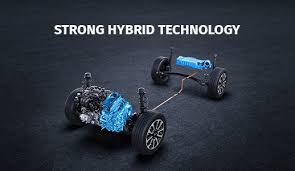Hybrid technology is becoming more popular. But what does it really mean? It’s a system that merges two or more different types of power.
This usually involves combining a traditional fuel engine with an electric motor in cars. The aim is to boost fuel efficiency and cut down on emissions.
However, hybrid technology isn’t just for vehicles. It’s also used in cloud computing, where it blends public and private cloud services. This provides businesses with more flexibility and control.
What is Hybrid Technology?
Hybrid technology brings together different types of power systems to improve efficiency. It combines the advantages of various sources for better performance.
- In cars, hybrid systems usually mix a gasoline engine with an electric motor. This combination helps save fuel and lower emissions.
- In the world of computing, hybrid cloud technology is common. It merges public cloud services with private cloud setups, providing both flexibility and security.
The hybrid approach isn’t limited to vehicles and IT. It’s also found in renewable energy systems. For example, combining wind turbines with solar panels and battery storage creates hybrid power solutions.
Here’s a summary of the main parts of hybrid technology:
- Various power sources for better efficiency.
- Use in cars, cloud computing, and renewable energy.
- Aim to lessen environmental effects.
- Providing greater flexibility and performance in systems.
- Connecting old and new technologies.
Grasping these essential aspects of hybrid technology shows how adaptable it is. It represents a modern step in balancing traditional and new solutions. As different applications keep expanding, the importance of hybrid technology grows.
Types of Hybrid Technologies
Hybrid Vehicles
Hybrid cars have really changed the game in the car world. They mix regular gas engines with electric motors, which means they’re better on fuel and produce less pollution.
These cars can easily switch between using gas and electricity. Mild hybrids give you a little electric boost, while full hybrids can run just on electricity when you need them to. Plug-in hybrids are great too because they have bigger batteries that let you drive further on electric power.
More people are turning to hybrids because of worries about the environment and rising gas prices. They’re a smart choice that’s good for the planet and easy to use, without giving up the convenience of a regular car.

Overall, hybrid vehicles balance performance and sustainability. They reduce dependence on fossil fuels, paving the way for a greener future.
Hybrid Cloud Technology
Hybrid cloud tech is changing how businesses use IT. This setup mixes public clouds with private cloud systems, letting companies make the most of their resources while keeping control over their data.
Businesses turn to hybrid clouds for their ability to scale. Public clouds can take on extra loads, while private clouds keep important data safe. This setup gives flexibility without giving up privacy.
Hybrid clouds are key for going digital. They help with smooth integration, making it easier for companies to adapt quickly. This is super important for staying competitive in today’s fast-paced market.

By bridging public and private systems, hybrid clouds provide tailored solutions. They align business needs with technological advancements for improved efficiency.
How Does Hybrid Tech Work?
In Vehicles
Hybrid vehicles function by integrating two power sources. The internal combustion engine works alongside an electric motor. These systems operate independently or together based on driving needs. During low-speed driving, hybrids often use electric power. This reduces fuel consumption and minimizes emissions. The engine takes over at higher speeds or when more power is required.
Regenerative braking is a key feature. It recovers energy lost during braking, charging the battery. This improves efficiency and extends the electric motor’s range.
In Cloud Computing
Hybrid cloud computing mixes public and private clouds. Each type has its own job based on what resources are needed and how secure the information is. This setup helps with flexibility while keeping sensitive data safe. Data and applications can move easily between the clouds, allowing companies to quickly grow their operations. Public clouds manage changing workloads, which helps cut down on infrastructure costs.
Security is upheld by storing sensitive information on private clouds. This blend helps with following rules and protecting data. Companies can innovate freely without risking their compliance needs.
Benefits of Hybrid Technology
Hybrid technology provides several advantages across various fields. It offers enhanced efficiency and cost savings. These benefits attract both consumers and businesses alike.
Hybrid vehicles use less fuel, reducing overall costs. They also produce fewer emissions, contributing to a cleaner environment. Energy conservation is a significant benefit for environmentally conscious consumers.
In cloud computing, hybrid systems deliver flexibility. They combine on-premise and cloud resources, optimizing IT operations. This flexibility supports different workloads and business growth.
Key benefits of hybrid technology include:
- Reduced energy consumption and emissions
- Enhanced operational flexibility and scalability
- Lower operational and maintenance costs
- Increased access to innovative technologies
Hybrid solutions help balance performance with sustainability. They represent a shift toward greener, more efficient practices. Their growing adoption reflects a commitment to a sustainable future.
Conclusion: Why Hybrid Technology Matters
Hybrid technology plays a vital role in today’s world. By combining different power sources, it enhances efficiency and minimizes environmental impact. This dual approach makes it a cornerstone in the transition towards greener solutions.
The benefits of hybrid systems extend beyond immediate gains. They offer a path forward in sustainable development across industries. As technology progresses, hybrid solutions will continue to reshape how we approach energy and computing.










